|
|
||||||||||
|
|
|
|
|
|
||||||
|
|
||||||||||

SUBJECTS
FISHERIES AND OCEANS CANADA - STEWARDS OF CANADA'S WATERS

 Published by:
Published by:
Communications Branch
Fisheries and Oceans Canada
Ottawa, Ontario
K1A 0E6
DFO/6069
© Her Majesty the Queen in Right of Canada, 2001
Cat. No. Fs23-400/2001E-IN
0-662-31124-8
Table of Contents
Securing Canada’s Economic Interests in the Oceans
Canada’s Oceans Act: Seeing the Big Picture
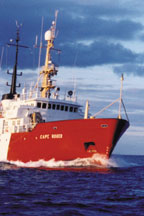 Stewards of Canada’s Waters
Stewards of Canada’s Waters
Our oceans and inland water system, and their resources, have played an important role in Canada’s history, identity and culture. Eight of the 10 provinces and all three territories have ocean shorefront, and nearly a quarter of Canadians live in coastal communities. Canada’s inland water system — particularly the St. Lawrence Seaway and the Great Lakes — has also played a crucial role in Canada’s development.
Canada’s oceans, shorelines and inland waters support a growing number of industries and uses. Shipping, fishing, aquaculture, ecotourism, boating, oil and gas extraction, and other ocean activities contribute an estimated $20 billion a year to the Canadian economy. But for Canada’s seven million coastal residents, the social, spiritual and cultural value of our oceans is even greater than their economic worth.
Oceans play an important role in the global ecosystem. They harbour most of the planet’s flora and fauna and regulate the Earth’s climate. But contamination from industry, farming, urban waste and forestry operations, coupled with atmospheric changes and competing demands for ocean resources themselves, are putting the world’s oldest life-support system in jeopardy. These factors may soon cause irreversible damage to Canada’s fisheries and marine and freshwater environments.
Protecting Canada’s economic, environmental and scientific interests in its oceans and waterways is a federal government responsibility. The Government of Canada has assigned that job to Fisheries and Oceans Canada. The department exists to maintain the productivity of Canada’s fisheries and oceans, protect marine and freshwater resources, ensure public safety and efficient vessel traffic along Canada’s oceans and inland waterways, and generate the knowledge that policymakers need to make informed resource management decisions. To achieve its mandate, Fisheries and Oceans Canada works closely with provincial and territorial governments, Aboriginal communities and stakeholders through its regional offices and various consultation mechanisms.
A Precious Legacy
Canada’s oceans and inland waterways, and their resources, provide great social, economic and environmental benefits.
But they are also finite and vulnerable, and therefore must be protected and managed for the benefit of present and future generations.
 Securing Canada’s Economic Interests in the Oceans
Securing Canada’s Economic Interests in the Oceans
Canada’s oceans and inland waters play a key role in our economy. Commercial and recreational fishing are important sources of revenue in parts of Canada where few other economic opportunities exist. The Atlantic fishing industry employs more than 100,000 people in Atlantic Canada. And the Pacific fisheries provide employment for 17,000 fishers and plant workers. Despite declines in the historically valuable groundfish stocks of Atlantic Canada and the lucrative salmon fisheries of the Pacific coast, abundant harvests of snow crab, lobster and shrimp are pushing Canadian fishery exports to new highs. In 2000, Canada’s fish and seafood exports reached almost $4.1 billion — the highest value on record. And Canadian sport fishing continues to inject billions of dollars into local economies each year.
The viability of many of Canada’s coastal communities is directly linked to the health of the fisheries. As world demand for fish and seafood products soars, there is a need to be increasingly vigilant about the health of our fisheries and the integrity of the ecosystems that support them. New technologies have made it easier to catch and process far more fish than can be harvested sustainably. In other words, there simply may not be enough wild fish to keep pace with the rising demand. The decline of some historically valuable stocks in the 1990s made it clear that fisheries are complex living systems that respond to human activity and global environmental changes in unpredictable and variable ways.
Given the rising world demand for fisheries products and our growing capacity to harvest them, effective fisheries management has become more important than ever. The job of Fisheries and Oceans Canada is to continue to understand the complex factors governing fish abundance, to regulate the harvest, and to preserve fish habitat so Canadian fisheries will remain viable. The department is also working to ensure that Canada’s growing aquaculture industry will be well-positioned to take advantage of the expanding world market for fish.
 Promoting conservation, co-operation and compliance
Promoting conservation, co-operation and compliance
To ensure that Canada’s fisheries resources are harvested sustainably, Fisheries and Oceans Canada has taken steps to improve information sharing and increase participation in fisheries management by a wide array of resource users, including commercial harvesters, the recreational fishing sector and Aboriginal groups.
The long-term well-being of Canada’s fisheries depends on shared stewardship, co-operation and stakeholder accountability. As fishers assume greater responsibility for the future of the fisheries, people who make their living from marine resources will be better placed to harvest those resources sustainably. In the commercial fishery, shared stewardship will not only create greater incentives for conservation, it will also increase certainty, and make true, long-term business planning possible. And, as licence-holders become more self-reliant, the federal government expects to withdraw from fisheries micromanagement and concentrate instead on policy-making, research and enforcement.
How does Canada manage its fisheries?
Every year, departmental scientists assess the size and health of many different fish stocks to determine appropriate conservation measures, including an acceptable annual catch limit for most species. The department then allocates the allowable catch among various users, including commercial harvesters, the recreational fishing sector and Aboriginal fishers.
The department’s fisheries management team also establishes policies, guidelines, regulations and conditions for harvesting. Six hundred Fishery Officers stationed around the country monitor the harvest and verify the size of fish landings to ensure that licence-holders are honouring the rules of the fishery. The magnitude of this management operation is staggering.
The department manages close to 200 fisheries, comprising thousands of different breeding populations.
Fisheries and Oceans Canada also runs educational programs for recreational and commercial fishers, teaching catch-and- release methods, species identification, and the use of gear that targets specific species of fish.
 This process has already begun. Canada’s fishing industry has long played a role in aquatic resource management and fisheries science. It has developed and adopted a
Canadian Code of Conduct for Responsible Fishing Operations that has since been ratified by more than 50 commercial fishing organizations across Canada. Fishers on the East and West coasts, Inuit fishers in the Arctic, and freshwater commercial fishers in Alberta, Saskatchewan, Manitoba and Ontario are all demonstrating that they are not as interested in mere compliance as they are in taking leadership to conserve the resource on which their livelihoods depend. Commercial fleets and fishing industry associations in some fisheries are not only sharing management costs and participating in decision-making; they are also collaborating with the department on fisheries research and development. For example, the department and its fishing industry partners have established new surveys of exploited stocks, and have worked together to explore the feasibility of establishing sustainable fisheries for underutilized species such as skate, monkfish and rock crab in the Maritimes and Gulf regions.
This process has already begun. Canada’s fishing industry has long played a role in aquatic resource management and fisheries science. It has developed and adopted a
Canadian Code of Conduct for Responsible Fishing Operations that has since been ratified by more than 50 commercial fishing organizations across Canada. Fishers on the East and West coasts, Inuit fishers in the Arctic, and freshwater commercial fishers in Alberta, Saskatchewan, Manitoba and Ontario are all demonstrating that they are not as interested in mere compliance as they are in taking leadership to conserve the resource on which their livelihoods depend. Commercial fleets and fishing industry associations in some fisheries are not only sharing management costs and participating in decision-making; they are also collaborating with the department on fisheries research and development. For example, the department and its fishing industry partners have established new surveys of exploited stocks, and have worked together to explore the feasibility of establishing sustainable fisheries for underutilized species such as skate, monkfish and rock crab in the Maritimes and Gulf regions.
Fisheries co-management agreements have been developed with fishing communities all over Canada. In British Columbia, for example, fishers both partly fund and participate in the decision-making process for the management of the halibut, sablefish and geoduck fisheries. Snow crab fishing fleets in Atlantic Canada are working with Fisheries and Oceans Canada and provincial governments to manage the area’s $100-million snow crab fishery. Aboriginal communities on all three coasts have signed formal agreements with the Government of Canada, providing for shared decision-making and shared responsibility for such fisheries management activities as monitoring and enforcement, stock assessment, habitat rehabilitation, and catch reporting.
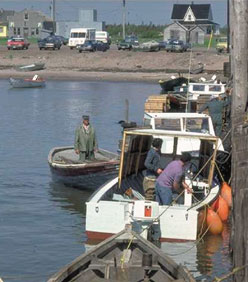 Fisheries and Oceans Canada has also worked to improve the balance between available resources and the people whose livelihoods depend on them. In addition to retiring hundreds of groundfish licences in parts of Atlantic Canada, the department has worked with commercial and recreational licence-holders and Aboriginal harvesters to develop and introduce conservation-based techniques. New regulations have made harvesting more selective; in Atlantic Canada, industry, government and university scientists now collaborate to determine appropriate quotas and acceptable harvesting methods for most fish stocks. The Pacific salmon fleet has been reduced by half, leaving a more viable fishery for the licence-holders who remain. Community-based habitat rebuilding and enhancement projects, as well as the increasing adoption of selective fishing practices, are helping to revive Pacific salmon populations.
Fisheries and Oceans Canada has also worked to improve the balance between available resources and the people whose livelihoods depend on them. In addition to retiring hundreds of groundfish licences in parts of Atlantic Canada, the department has worked with commercial and recreational licence-holders and Aboriginal harvesters to develop and introduce conservation-based techniques. New regulations have made harvesting more selective; in Atlantic Canada, industry, government and university scientists now collaborate to determine appropriate quotas and acceptable harvesting methods for most fish stocks. The Pacific salmon fleet has been reduced by half, leaving a more viable fishery for the licence-holders who remain. Community-based habitat rebuilding and enhancement projects, as well as the increasing adoption of selective fishing practices, are helping to revive Pacific salmon populations.
The Canadian Council of Fisheries and Aquaculture Ministers, composed of federal, provincial and territorial ministers responsible for fisheries, helps to ensure strong intergovernmental co-operation. In September 1999, all provincial and territorial ministers joined Fisheries and Oceans Canada in signing the Agreement on Interjurisdictional Co-operation with Respect to Fisheries and Aquaculture, which establishes a collaborative approach to guiding Canada’s fisheries in the years to come.
Conservation means sustainable use that protects ecological processes and genetic diversity.
Preserving fish habitat: No net loss
The long-term productivity of Canada’s fisheries depends on more than just wise harvesting. Fish depend on the availability of clean water, spawning and rearing grounds, an adequate food supply and clear migration routes. Healthy fish habitats are the fisheries’ lifeline. That’s why the Fisheries Act mandates Fisheries and Oceans Canada to protect those habitats in every river, lake, stream, estuary and ocean in Canada.
 It’s a tall order. The threats to fish habitat are many and varied. Forestry, mining and hydroelectric installations can impede the natural flow of water and introduce debris and contaminants. Urban development, industrial discharge, road building and agriculture all contribute to habitat loss.
It’s a tall order. The threats to fish habitat are many and varied. Forestry, mining and hydroelectric installations can impede the natural flow of water and introduce debris and contaminants. Urban development, industrial discharge, road building and agriculture all contribute to habitat loss.
TheFisheries Act prohibits any activity that results in the harmful alteration, disruption or destruction of fish habitat. Departmental biologists assess the potential impact of proposed developments near water and recommend changes in project design to avoid or minimize damage. Because the preservation of fish habitat competes with other important economic activities, such as farming and natural resource development, the destruction of fish habitat is sometimes inevitable. In cases where damage to fish habitat cannot be avoided, the federal government’s fish habitat management policy requires that these losses be offset by habitat gains elsewhere. The department’s habitat biologists and engineers provide the technical assistance needed to help developers mitigate the loss of habitat in one area by creating or improving fish habitat nearby.
In addition to administering the Fisheries Act, the department encourages resource managers in other government agencies as well as in the private sector to incorporate fish habitat priorities into their air, land and water use plans. For example, through initiatives like the Salmonid Enhancement Program on the Pacific coast, Fisheries and Oceans Canada is finding ways to support community-based efforts to restore, enhance and conserve our fisheries resources. The department also publicizes how human activities contribute to habitat loss, and promotes public action to conserve, restore and develop Canada’s fish habitats in both marine and freshwater environments.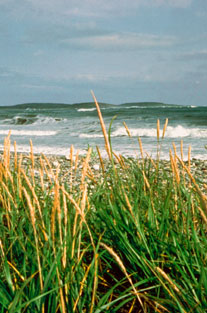
With a view to achieving a net gain in fish habitat, the department’s scientists and resource engineers work not only to protect existing habitats, but also to rehabilitate endangered areas and even to develop new places where fish can feed, spawn and rear their young.
Aquaculture: Cultivating new jobs
 |
| Photo: Government of New Brunswick |
The growing world demand for fish, coupled with the inability of wild fish stocks to sustainably meet demand, has kindled much interest in aquaculture — the farming of fish, shellfish and aquatic plants in fresh, brackish or salt water. Aquaculture currently produces nearly a third of the fish and shellfish consumed worldwide; by 2010 it could account for nearly half of the world’s fisheries’ production. In Canada, aquaculturists are cultivating everything from salmon and halibut, to mussels and scallops. In doing so, they are bringing much needed economic diversification to many coastal communities.
Fisheries and Oceans Canada’s challenge over the coming years is to foster the growth of a sustainable aquaculture industry by enhancing public confidence in the sector and increasing the industry’s global competitiveness. These objectives will be accomplished through a commitment to maintaining a healthy environment, ensuring healthy fish and quality products, and co-operatively managing our aquatic resources.
Fisheries and Oceans Canada’s Program for Sustainable Aquaculture encourages environmental and economic sustainability for this industry through increased investments in research and development, enhanced resources for the Canadian Shellfish Sanitation Program, and the support of an improved management and regulatory framework for aquaculture in Canada. Fisheries and Oceans Canada is also investigating other initiatives — such as a national aquatic animal health program — that will further enhance the competitiveness of aquaculture and other fishery sectors in Canada, while supporting the sustainable use of our aquatic resources.
Fisheries and Oceans Canada is collaborating with partners in private industry, provinces, and academia to extract new opportunities from our aquatic resources through the development of a regulatory and policy climate that is supportive of a healthy environment, a sustainable industry and excellence in research.
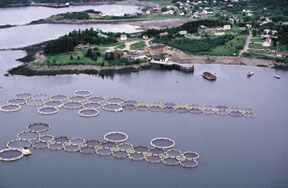
|
| Photo: Government of New Brunswick |
In addition to traditional aquaculture, the oceans are home to a wealth of life forms whose significance we have not yet even begun to fathom. Biotechnology research has demonstrated that our aquatic resources are a potential gold mine of new products for biomedical and veterinary applications, wastewater treatment, food processing, cosmetics and bioelectronics. Fostering a supportive policy and regulatory climate for these expanding aquaculture opportunities will help fuel the creation of new knowledge-based and technologically sophisticated jobs and trade opportunities.
Safeguarding marine cargo
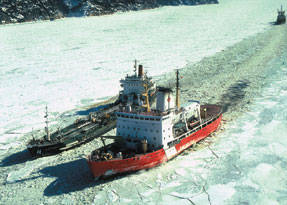 Every year, billions of dollars’ worth of Canadian commodities and manufactured goods are transported by ship to markets all over the world. To keep these transport vessels moving safely and efficiently through Canadian waters, the Canadian Coast Guard (CCG) provides navigational assistance, traffic services and a communications link between ships in distress and shore-based search and rescue authorities, while the Canadian Hydrographic Service provides nautical charts and tide tables to assist in safe navigation.
Every year, billions of dollars’ worth of Canadian commodities and manufactured goods are transported by ship to markets all over the world. To keep these transport vessels moving safely and efficiently through Canadian waters, the Canadian Coast Guard (CCG) provides navigational assistance, traffic services and a communications link between ships in distress and shore-based search and rescue authorities, while the Canadian Hydrographic Service provides nautical charts and tide tables to assist in safe navigation.
An arm of Fisheries and Oceans Canada, the CCG also helps cargo vessels negotiate ice-infested waters by issuing ice warnings and routing information. In autumn, winter and spring, CCG icebreakers escort ships along the Atlantic coast and through the Gulf of St. Lawrence, St. Lawrence Seaway and Great Lakes.
Thanks to the CCG’s navigational, traffic, ice-breaking and search and rescue services, Canada’s commercial waterways — from the Fraser River in the west to the St. Lawrence in the east — are among the safest in the world.
 Canada’s Oceans Act: Seeing the Big Picture
Canada’s Oceans Act: Seeing the Big Picture
Oceans and freshwater are a finite resource, yet the scale and diversity of oceans-related activities are growing dramatically. Commercial fishing fleets, fish farmers, recreational boaters, ecotourists, cruise ship operators, offshore oil and gas developers and marine transport companies all compete for a piece of the ocean. At times their interests collide. The growth of coastal and oceans-related activities has resulted in ecosystem imbalances, degradation of the marine environment and the introduction of potentially harmful species. Spills from marine users poison aquatic life and contaminate once-pristine beaches. And trillions of litres of pollutants and untreated sewage are flushed into Canada’s waters every day.
 Our fisheries, fish farms, waterways and aquatic playgrounds are part of a complex and increasingly vulnerable natural system. The impacts of the many threats to our waterways are cumulative, and we need a long-term, integrated way of dealing with them. The system must be protected if our oceans and freshwaters are to keep producing food, harbouring aquatic life, providing recreational opportunities, creating jobs and anchoring Canada’s coastal communities.
Our fisheries, fish farms, waterways and aquatic playgrounds are part of a complex and increasingly vulnerable natural system. The impacts of the many threats to our waterways are cumulative, and we need a long-term, integrated way of dealing with them. The system must be protected if our oceans and freshwaters are to keep producing food, harbouring aquatic life, providing recreational opportunities, creating jobs and anchoring Canada’s coastal communities.
 With the longest coastline of any country in the world, and territory on the Atlantic, Pacific and Arctic oceans, Canada has a major responsibility for ocean stewardship. The federal government has taken this seriously. Hundreds of federal laws and regulations govern everything from illegal fishing to boating safety, Arctic pollution, hazardous-waste shipments and the protection of navigation rights. The
Oceans Act mandates Fisheries and Oceans Canada to manage Canada’s coastal and marine waters in the interests of all Canadians. Enacted in 1997, the legislation paved the way for a national oceans strategy based on the principles of sustainable development and integrated management, and a commitment to err on the side of caution when scientific information is lacking or incomplete.
With the longest coastline of any country in the world, and territory on the Atlantic, Pacific and Arctic oceans, Canada has a major responsibility for ocean stewardship. The federal government has taken this seriously. Hundreds of federal laws and regulations govern everything from illegal fishing to boating safety, Arctic pollution, hazardous-waste shipments and the protection of navigation rights. The
Oceans Act mandates Fisheries and Oceans Canada to manage Canada’s coastal and marine waters in the interests of all Canadians. Enacted in 1997, the legislation paved the way for a national oceans strategy based on the principles of sustainable development and integrated management, and a commitment to err on the side of caution when scientific information is lacking or incomplete.
The strategy will seek to balance economic, environmental and social goals for the use of Canada’s oceans by providing Canadians with the tools to manage the increasing complexity and diversity of oceans use. Based on the principle of shared stewardship, the strategy will engage Canadians in decision-making processes that affect Canada’s oceans.
Because of its Oceans Act responsibilities, Fisheries and Oceans Canada has an important role to play in implementing the Canadian Oceans Strategy. This includes:
- the creation of Marine Protected Areas for the conservation and protection of marine resources, including endangered species, fisheries resources, unique habitats or areas of high biodiversity or biological productivity;
- the establishment of marine environmental quality objectives, guidelines, criteria and standards designed to conserve and protect the integrity and health of ocean ecosystems;
- the identification, in co-operation with the scientific community, of indicators to monitor ecosystem health; and
- the involvement of local groups of citizens, Aboriginal communities, and other stakeholders in determining the best mix of conservation, sustainable use and economic development for Canada’s estuaries and coastal and marine waters.
Canadians across the country have already demonstrated a high level of commitment to the conservation, protection, and responsible management of Canada’s gifts from the sea.
 Protecting the Environment: Responding to Emergencies
Protecting the Environment: Responding to Emergencies
Another way that Fisheries and Oceans Canada helps protect Canada’s oceans and their resources is by responding to spills in Canadian waters. Canadian law requires that ship owners and oil-handling facilities be prepared to deal with pollution and assume the costs of containment and cleanup. Ships and oil-handling facilities contract with a network of private-sector emergency response organizations, which are responsible for cleaning up spills. The Canadian Coast Guard (CCG) certifies and monitors these organizations to ensure their competence and readiness. Even so, a spill is sometimes too big or too far away for private-sector responders to handle.
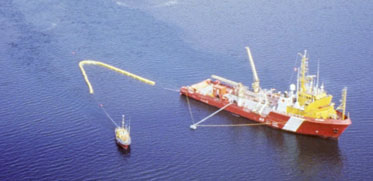 The CCG steps in to take charge of the cleanup when the private sector is unable to respond adequately to a spill, and maintains a comprehensive inventory of marine pollution control equipment, strategically positioned throughout the country. It ensures the rapid and environmentally friendly cleanup of substances that are harmful to the environment, and provides advice and emergency response capabilities to other government departments.
The CCG steps in to take charge of the cleanup when the private sector is unable to respond adequately to a spill, and maintains a comprehensive inventory of marine pollution control equipment, strategically positioned throughout the country. It ensures the rapid and environmentally friendly cleanup of substances that are harmful to the environment, and provides advice and emergency response capabilities to other government departments.
 CCG staff have extensive experience not only responding to spills, but also preparing for and preventing them. CCG contingency planning officers work with industry and environmental groups, emergency response organizations and other governments to develop, update, test and execute contingency plans for use in the event of a spill in Canadian waters.
CCG staff have extensive experience not only responding to spills, but also preparing for and preventing them. CCG contingency planning officers work with industry and environmental groups, emergency response organizations and other governments to develop, update, test and execute contingency plans for use in the event of a spill in Canadian waters.

|
| Photo:Greg Kilmes |
Keeping People Safe
Every year, the CCG assists thousands of vessels — involved in such activities as commercial shipping, fishing and recreation — by monitoring their distress signals, coordinating search and rescue operations, marking dangerous passages and providing navigational aids such as buoys, beacons and channel markers on Canada’s busiest waterways. In fact, the CCG has more than 20,000 buoys and beacons in place to assist users of our waterways and three oceans. Aids to navigation, used with charts provided by Canadian Hydrographic Services, make the single greatest contribution to the safety of life at sea, and prevent damage to our environment by keeping mariners "off the rocks"!
 CCG-operated Marine Communications and Traffic Services centres continuously monitor international distress frequencies for possible emergencies and communications needs. Ongoing broadcasts of weather, navigation hazards, ice reports and other key information give mariners the information they need to get where they’re going safely.
CCG-operated Marine Communications and Traffic Services centres continuously monitor international distress frequencies for possible emergencies and communications needs. Ongoing broadcasts of weather, navigation hazards, ice reports and other key information give mariners the information they need to get where they’re going safely.
 The CCG’s Office of Boating Safety provides the recreational boating community with a full range of services to enhance operator knowledge and proficiency, the safety of the vessel itself, appropriate equipment carriage (such as lifejackets), and safe vessel operation. Working closely with the boating community, it delivers prevention-based programs to reduce the safety risks and environmental impacts of boating on all waters in Canada. As a result of new regulations being phased-in between 1999 and 2009, the CCG has also begun to implement competency requirements for operators of pleasure craft fitted with a motor.
The CCG’s Office of Boating Safety provides the recreational boating community with a full range of services to enhance operator knowledge and proficiency, the safety of the vessel itself, appropriate equipment carriage (such as lifejackets), and safe vessel operation. Working closely with the boating community, it delivers prevention-based programs to reduce the safety risks and environmental impacts of boating on all waters in Canada. As a result of new regulations being phased-in between 1999 and 2009, the CCG has also begun to implement competency requirements for operators of pleasure craft fitted with a motor.
 When accidents do happen, help is often close at hand. The CCG coordinates the activities of the Canadian Coast Guard Auxiliary, a corps of 5,000 volunteers and 1,500 vessels that helps the CCG respond to distress calls and deliver prevention services. And the CCG’s Search and Rescue program responds to a range of marine emergencies, providing skilled, professional crews and specialized vessels and equipment.
When accidents do happen, help is often close at hand. The CCG coordinates the activities of the Canadian Coast Guard Auxiliary, a corps of 5,000 volunteers and 1,500 vessels that helps the CCG respond to distress calls and deliver prevention services. And the CCG’s Search and Rescue program responds to a range of marine emergencies, providing skilled, professional crews and specialized vessels and equipment.
The department also helps local harbour authorities safely maintain the network of small craft harbours that provide refuge to Canada’s commercial fishing fleets and recreational boaters. Fisheries and Oceans Canada monitors the physical condition of these harbours, provides the professional and technical expertise needed to operate and maintain them, and helps fund repair projects.
 Putting Knowledge to Work
Putting Knowledge to Work
Unlike terrestrial environments, ocean and freshwater environments, for the most part, cannot be directly observed. What happens beneath the surface and away from the shoreline can only be observed with specialized equipment, vessels, and highly developed techniques. Part of the department’s job is to observe and understand the oceans and their ecosystems.
 Nearly all of the department’s operations are heavily dependent on science. The conservation of aquatic ecosystems and the sustainable use of fisheries resources depend on a solid understanding of how marine and freshwater ecosystems work and how they are affected by human activity and natural stresses. Scientific research provides the information that guides the development of national standards for fish habitat management and effective methods for the conservation, restoration and development of those habitats.
Nearly all of the department’s operations are heavily dependent on science. The conservation of aquatic ecosystems and the sustainable use of fisheries resources depend on a solid understanding of how marine and freshwater ecosystems work and how they are affected by human activity and natural stresses. Scientific research provides the information that guides the development of national standards for fish habitat management and effective methods for the conservation, restoration and development of those habitats.

|
| Photo: Canadian Scientific Submersible Facility |
With its network of leading-edge marine research facilities and some of the most sophisticated research vessels in the world, the department’s expertise in ocean and freshwater science is recognized worldwide. The department collaborates extensively with universities, foreign governments and private-sector partners in the fishing industry and the marine transport and telecommunications sectors.
Understanding climate change
Knowledge about the changing chemistry and physics of the marine environment and the complex interplay between oceans and climate is vital to our understanding of climate change and its potential impact on Canada’s wildlife, forests and agriculture.
Rising world temperatures are warming our waters to temperatures that are potentially dangerous to certain fish stocks. Some parts of Canada’s Arctic ice fields are a full metre thinner than they were three decades ago. The spring break-up of Arctic ice begins more than three weeks earlier than it used to, making it increasingly difficult for polar bears to reach the seals that are their principal food source. Information from the department’s ocean science programs makes it possible for resource managers and policymakers to anticipate and prevent potential damage to Canadian facilities and resources, and to plan for changes in growing conditions and settlement patterns.
 Because the oceans play a critical role in regulating the Earth’s climate, studying changes in ocean temperatures and currents — and their relationship to extreme weather events and global warming — generates important new knowledge about global environmental change. This knowledge will enable resource managers to anticipate and plan for changes in fisheries productivity, and to mitigate effects on other marine life.
Because the oceans play a critical role in regulating the Earth’s climate, studying changes in ocean temperatures and currents — and their relationship to extreme weather events and global warming — generates important new knowledge about global environmental change. This knowledge will enable resource managers to anticipate and plan for changes in fisheries productivity, and to mitigate effects on other marine life.
Bringing New Precision to Marine Navigation
As Canada’s oceans and waterways experience increasing commercial and recreational traffic, the inability of mariners to negotiate narrow passages and inhospitable weather could cause loss of life or have serious environmental and economic consequences. Recreational boaters, marine transport operators and fishers alike depend on the nautical charts and tide and current tables produced by the Canadian Hydrographic Service.
The shipping companies that transport commodities such as grain, lumber, fuel oil and coal in and out of North American ports need accurate information about tides, currents and water depth to ensure the safe transit of their cargoes. Since each additional centimetre of cargo draft represents an extra $5,000 in shipping revenue, marine transport operators have a keen interest in knowing exactly how much cargo they can carry safely.
Working with the marine transport industry, the Canadian and U.S. coast guards and various international organizations, the Canadian Hydrographic Service is advancing the research, development and use of electronic chart and display information systems. Touted as the most important advance in marine navigation of the past 100 years, these navigational aids make it possible to manoeuvre massive cargo ships with a precision never before possible. Combining digital hydrographic data with satellite-generated global positioning data, this new technology enables mariners to receive real-time information about their vessel’s coordinates, potential obstacles, water depth and current speeds on a video monitor in the ship’s control room.
 Assessing fish stocks
Assessing fish stocks
Fisheries contribute billions of dollars annually to Canada’s economy, and are one of the mainstays of our coastal communities. Fish harvesting can only be sustainable if it is based on sound knowledge of the state of stocks and the measures required to protect them. Fisheries and Oceans Canada’s fisheries science program maintains information on hundreds of stocks, including abundance, growth, additions of young fish, responses to the marine environment, migrations, and mortality from fishing and natural factors. Scientists forecast the allowable catch levels and advise on a wide range of conservation measures, such as size limits, limits on the amount of fish gear, and areas and seasons of fishing. The results are widely distributed via the Internet, so that fishers and the general public can be aware of the state of the stocks. The department also benefits from the knowledge of experienced fishers, many of whom have valuable information about stocks and their behaviour and habitats.
Developing indicators of marine environmental quality
By the time major fisheries collapse or marine mammal populations become depleted, the damage may be irreversible. Because all marine creatures are interconnected, recognizing early warning signs — such as changes in the abundance of the microscopic plants and mammals that underpin the food chain — should make it possible to ward off serious environmental problems. By learning more about the relationships among water temperature, water quality, contaminant levels, plant and animal abundance and so on, it will be possible to develop dependable criteria and indicators for assessing marine ecosystem health, better managing our fisheries and habitat, and intervening to protect the quality of the marine environment.
 Maintaining good relations with Canada’s neighbours, trading partners and the global community
Maintaining good relations with Canada’s neighbours, trading partners and the global community
Fisheries and Oceans Canada plays a key role in advancing Canada’s fisheries conservation interests by negotiating and administering international treaties and agreements that regulate fishing in Canadian waters and for those "straddling" stocks that migrate in and out of Canada’s 200-nautical mile Fishing Zone.
For instance, Fisheries and Oceans Canada recently negotiated a new agreement under the Canada-U.S. Pacific Salmon Treaty, which put in place new long-term fishing arrangements for each of the Pacific salmon stocks, as well as new arrangements for science, fisheries management and habitat protection.
Canada has also taken bold measures to protect high seas fish stocks from over-exploitation by successfully pressing for a multilateral treaty to protect and manage straddling and highly migratory fish stocks. Fisheries and Oceans Canada continues to work with other government departments and its counterparts in other countries to speed the ratification and full implementation of the United Nations Fish Agreement by key fishing states.
To help keep global markets open to Canadian fish and seafood products, Fisheries and Oceans Canada provides scientific and policy advice to the Department of Foreign Affairs and International Trade. Together the two departments represent the interests of Canadian producers of fisheries products by negotiating the elimination of tariffs and other trade barriers. Canada is also a major player in such intergovernmental bodies as the United Nations Food and Agriculture Organization and the International Maritime Organization.
 Enjoying the Wealth Today and Tomorrow
Enjoying the Wealth Today and Tomorrow
With a coastline that could stretch six times around the globe, Canada has a major interest in the oceans and their welfare. Fisheries and Oceans Canada will continue to work with Canadians to safeguard this precious legacy now and in the future.
For more information about Fisheries and Oceans Canada and its programs, visit www.dfo-mpo.gc.ca or contact the department at:
Fisheries and Oceans Canada
Communications Branch
200 Kent Street Ottawa,
Ontario Canada
K1A 0E6
Tel: (613) 993-0999
Fax: (613) 990-1866
TDD: (613) 941-6517
In the regions
Pacific Region
400, 555 West Hastings Street
Vancouver, British Columbia
V6B 5G3
Telephone: (604) 666-0384
Facsimile: (604) 666-1847
Gulf Region
343 Université Avenue
P.O. Box 5030 Moncton,
New Brunswick
E1C 9B6
Telephone: (506) 851-7747
Facsimile: (506) 851-2435
Newfoundland Region
Box 5667
St. John’s, Newfoundland
A1C 5X1
Telephone: (709) 772-4423
Facsimile: (709) 772-4880
Central and Arctic Region
501 University Crescent
Winnipeg, Manitoba
R3T 2N6
Telephone: (204) 983-5000
Facsimile: (204) 984-2401
Maritimes Region
176 Portland St.
P.O. Box 1035
Dartmouth, Nova Scotia
B2Y 4T3
Telephone: 1-800-782-3058
Facsimile: (902) 426-5995
Laurentian Region
104 rue Dalhousie
Québec, Québec
G1K 7Y7
Telephone: (418) 648-7747
Facsimile: (418) 648-7718